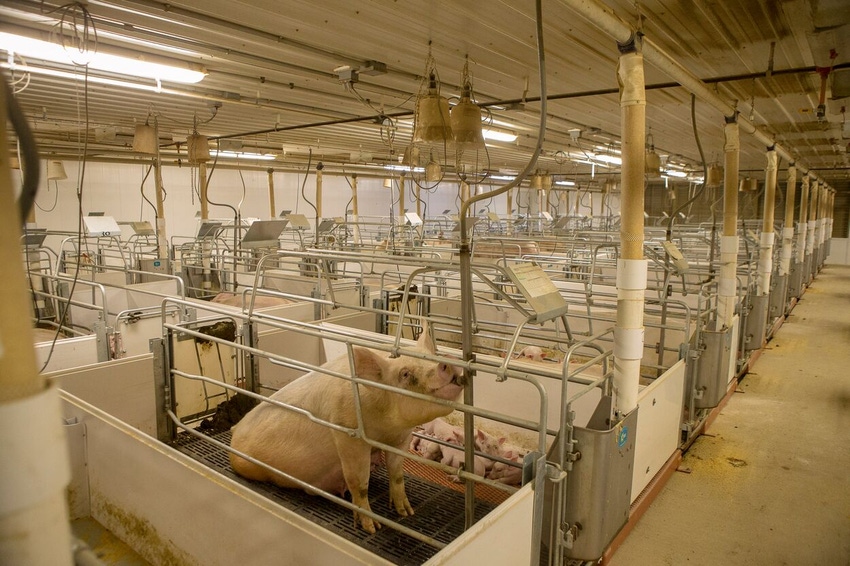Piglet survival was significantly improved in sows that farrowed at the front of the room near the cool air inlets.
August 4, 2022

Heat stress costs U.S. pig farmers hundreds of millions of dollars each year in lost productivity (St-Pierre et al., 2003). Facility design and maintenance can very much help in the battle to mitigate the impact of heat stress on pig productivity.
While production systems often validate farm-to-farm variation in relation to seasonality in reproduction, evaluating facility variation within a farm is less common. Therefore, the objective of the current study was to evaluate the impact of sow location, within the farrowing room, on reproduction during periods of heat stress.
Data was collected on 1,866 sows at a 3,600 sow commercial farm in eastern North Carolina from May to August 2021. In the farrowing buildings, evaporative cool cell pads cooled the air entering the hallway (Figure 1). Cooled air, from the hallway, then entered the farrowing rooms through inlets at the front of the room and was pulled through the room by a series of fans in the back of the farrowing room.
For data analysis, each farrowing room was divided into four zones. Zone 1 included the sows at the front of the farrowing room near the inlets letting in cooled air. Zone 4 included sows at the back of the room where air exited the building through fans embedded within the wall. Zones 2 and 3 were sows housed in between zones 1 and 4. Each farrowing room on the farm housed between 18 and 36 sows.
After farrowing, sows had ad libitum access to the lactation diet. At birth, piglets received a numbered ear tag corresponding to birth litter. Traits recorded included: total number of piglets born, stillborns, crossfosters, number weaned, piglet survival (number weaned ÷ total number born), litter weaning weight, lactation length, the percentage of sows conceiving by seven days after weaning (includes sows culled for no heat), subsequent total number born, subsequent number born alive, subsequent stillborns, sow caliper (Knauer and Baitinger, 2015) score prefarrow, sow caliper score at weaning and sow caliper lactation loss.
Results
Reproduction, subsequent reproduction and body condition measures by farrowing zone are reported in Table 1. The percentage of stillborn piglets was numerically greater in the back of the farrowing room, however observed differences were not statistically different. Hence environmental differences within the farrowing room did not appear to greatly impact the farrowing process.
Piglet survival was significantly improved in sows that farrowed at the front of the room near the cool air inlets (Figure 2). Perhaps this data helps validate the adage that keeping sows comfortable augments piglet survival (Steve Horton, personal communication). Enhanced piglet survival at the front of the farrowing room likewise resulted in significantly more piglets weaned per litter.
Litter weaning weight was significantly heavier near the cool air inlets relative to the back part of the farrowing room. While a portion of the increased litter weaning weight was related to more piglets weaned per litter, much of the increase was the result of heavier piglets. Having helped weigh the majority of the litters, this finding matched the eyeball test as piglets at the front of the room consistently appeared heavier.
Besides influencing reproduction in the current litter, farrowing zone also significantly impacted subsequent reproduction. The percentage of sows that conceived by seven days after weaning, and eventually farrowed, was linearly associated with farrowing zone (Figure 3). The difference between farrowing zone 1 and zone 4 was 7.7%. Subsequent litter size was also significantly influenced by farrowing zone. While sows near the cool air inlets farrowed significantly more piglets in the subsequent litter relative to sows in the back of the farrowing room, the relationship between zone and litter size did not appear to be as linear as the association between zone and percentage of sows conceiving by seven days after weaning.
Sow caliper scores at weaning were significantly different across farrowing room zones. Sows that farrowed near the cool air inlets lost less body condition than sows that farrowed at the back of the farrowing room. Hence sows that farrowed at the front of the farrowing room lost less body condition, had greater piglet survival, heavier litter weaning weights and were more likely to be rebred and conceive by seven days after weaning relative to sows farrowing in the back of the farrowing room.
Facility improvements
As sow facilities age, pig farmers should evaluate the opportunity cost of maintaining their facilities. The current data validates that variation in productivity can result from facility variation within a farm. Scientists from North Carolina State teamed with technical experts at Hog Slat to evaluate needed facility improvements at the cooperating sow farm. The following list of recommendations were provided to the farm
Replenish attic insulation.
Replace/adjust evaporative cool cell pads in gestation and lactation.
Increase size of smallest fan in each farrowing room.
The authors would like to thank the pig farmers in eastern North Carolina for their continued cooperation in helping to train students, identify problems and find solutions for the pork industry. Please contact Mark Knauer via email with any questions.
References
Knauer, M. T., and D. J. Baitinger. 2015. The sow body condition caliper. Appl. Eng. Agric. 31:175-178.
St-Pierre, N. R., B. Cobanov, and G. Schnitkey. 2003. Economic losses from heat stress by US livestock industries. J. Dairy Sci. 86: E52-E77.
Source: Mark Knauer and Suzanne Leonard, who are solely responsible for the information provided, and wholly own the information. Informa Business Media and all its subsidiaries are not responsible for any of the content contained in this information asset.
You May Also Like



